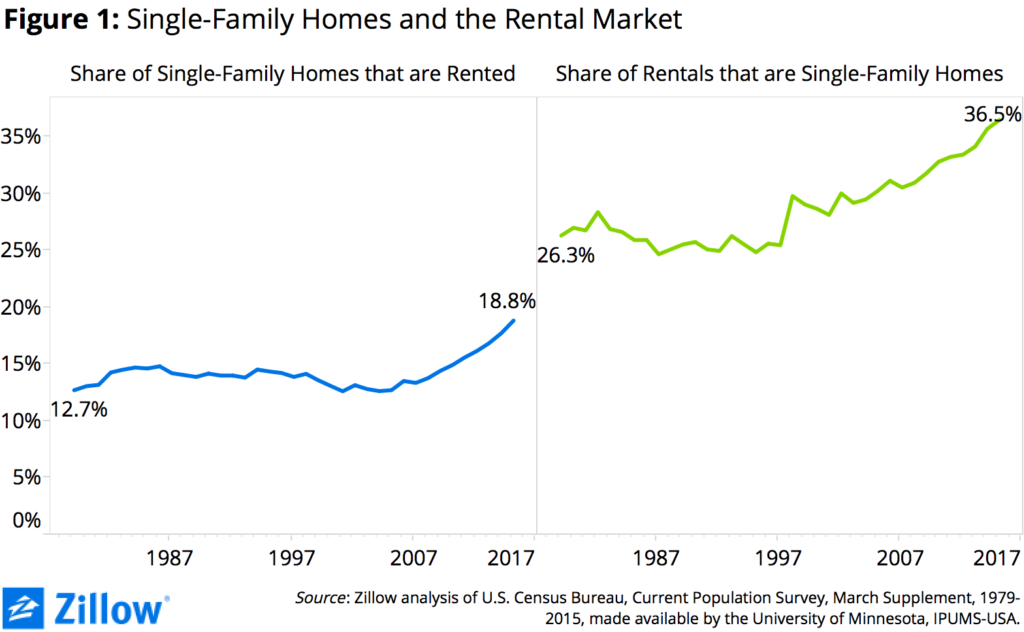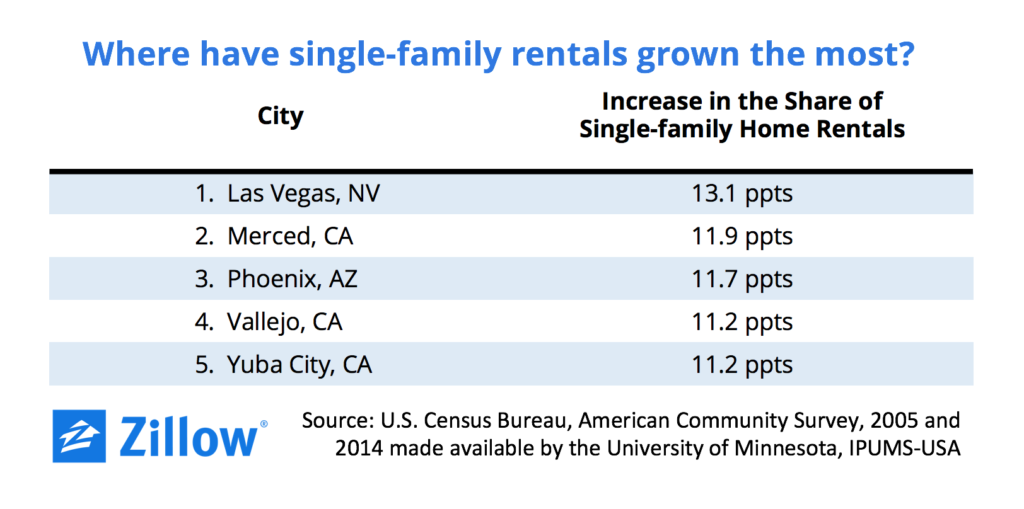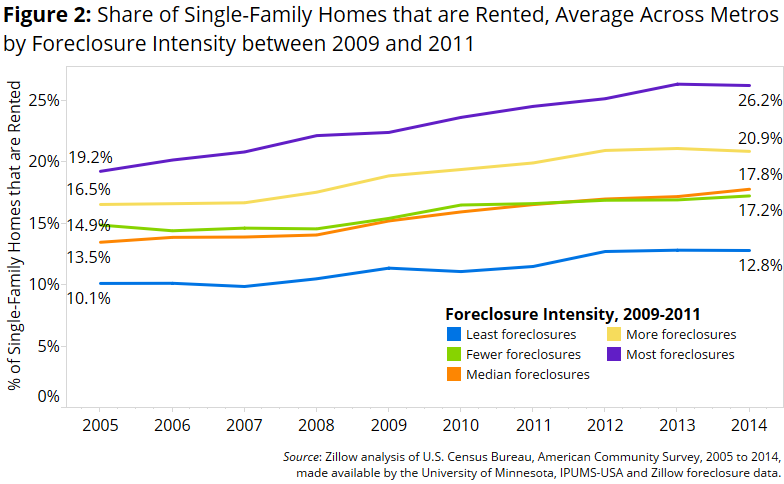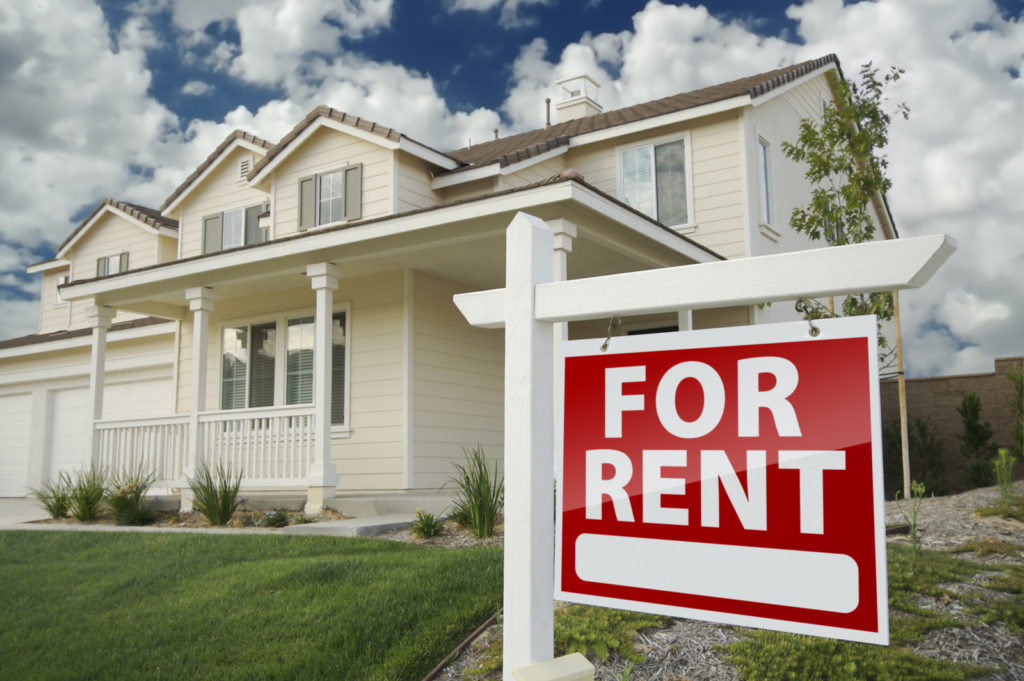Own-to-Rent: The Foreclosure Crisis and Single-Family Home Rentals
Once strongly associated with homeownership, a growing share of single-family homes are now being rented. And by extension, more of the country’s rental market is now composed of single-family homes.
- After holding stable for the better part of two decades, the share of single-family homes that are rentals has increased sharply since 2005.
- The increase in the share of single-family homes that are rented has been most prominent in the Southwest United States.
- Metro areas that experienced more foreclosures during the housing bust have seen a larger increase in the share of single-family homes that are rented.
Once strongly associated with homeownership, a growing share of single-family homes are now being rented. And by extension, more of the country’s rental market is now composed of single-family homes.
For much of the 1980s and 1990s, the share of single-family homes that were rented hovered between 12 percent and 15 percent, with the share falling modestly during the housing boom years. But since the housing bust, the share has skyrocketed: The share of single-family homes that are rented increased from 13.4 percent in early 2007 to 18.8 percent by early 2015.
Similarly, for much of the 1980s and 1990s single-family homes accounted for roughly one-quarter of the country’s rental market. On the eve of the housing bust, in spring 2007, single-family homes were 30.5 percent of all rental units. By spring 2015, they were 36.5 percent of all rental units (figure 1).
 The increase in the share of single-family homes that are rented has been most prominent in metro markets in the Southwest. Las Vegas experienced the largest increase, with the share of single-family homes that are rented rising 13.1 percentage points – from 16.1 percent in 2005 to 29.1 percent in 2014. It was followed by Merced, California (24.7 percent to 36.6 percent), Phoenix (11.8 percent to 23.4 percent) and Vallejo, California (14.7 percent to 25.9 percent).
The increase in the share of single-family homes that are rented has been most prominent in metro markets in the Southwest. Las Vegas experienced the largest increase, with the share of single-family homes that are rented rising 13.1 percentage points – from 16.1 percent in 2005 to 29.1 percent in 2014. It was followed by Merced, California (24.7 percent to 36.6 percent), Phoenix (11.8 percent to 23.4 percent) and Vallejo, California (14.7 percent to 25.9 percent).
 Given that Southwestern markets were hit very hard by the housing bust, it makes sense those markets saw a big increase in rented single-family homes. After being foreclosed upon, millions of families in need of a place to live turned to renting the same kind of single-family homes they had previously owned prior to foreclosure. During the years following the housing bust, investors purchased foreclosed homes and converted them to rentals in many communities to meet this demand.
Given that Southwestern markets were hit very hard by the housing bust, it makes sense those markets saw a big increase in rented single-family homes. After being foreclosed upon, millions of families in need of a place to live turned to renting the same kind of single-family homes they had previously owned prior to foreclosure. During the years following the housing bust, investors purchased foreclosed homes and converted them to rentals in many communities to meet this demand.
Our research shows that the share of single-family homes that are rentals has increased more in the metros with the most foreclosure activity (figure 2). We ranked metros by the intensity of foreclosures between 2009 and 2011, then took the average of the share of single-family homes in those metros that are rentals. In the metros with the most foreclosure activity, the share of single family homes that are rentals increased 7 percentage points from 19.2 percent in 2005 to 26.2 percent in 2014. In the metros with the least foreclosure activity, the share of single-family homes that are rentals increased by 2.7 percentage points, from 10.1 percent to 12.8 percent.
 As of the end of 2014, the metros with the largest shares of rented single-family homes were mostly in California’s Central Valley – Merced (36.6 percent), Modesto (31.3 percent), Yuba City (31.0 percent), Stockton (31.0 percent), Visalia (30.8 percent), Hanford (30.6 percent), Salinas (30.5 percent), Fresno (29.4 percent), and Santa Cruz (29.2 percent). The only metro in the top 10 that wasn’t in California was Fayetteville, North Carolina (32.0 percent), which is dominated by Fort Bragg, a U.S. Army base (figure 3).
As of the end of 2014, the metros with the largest shares of rented single-family homes were mostly in California’s Central Valley – Merced (36.6 percent), Modesto (31.3 percent), Yuba City (31.0 percent), Stockton (31.0 percent), Visalia (30.8 percent), Hanford (30.6 percent), Salinas (30.5 percent), Fresno (29.4 percent), and Santa Cruz (29.2 percent). The only metro in the top 10 that wasn’t in California was Fayetteville, North Carolina (32.0 percent), which is dominated by Fort Bragg, a U.S. Army base (figure 3).



